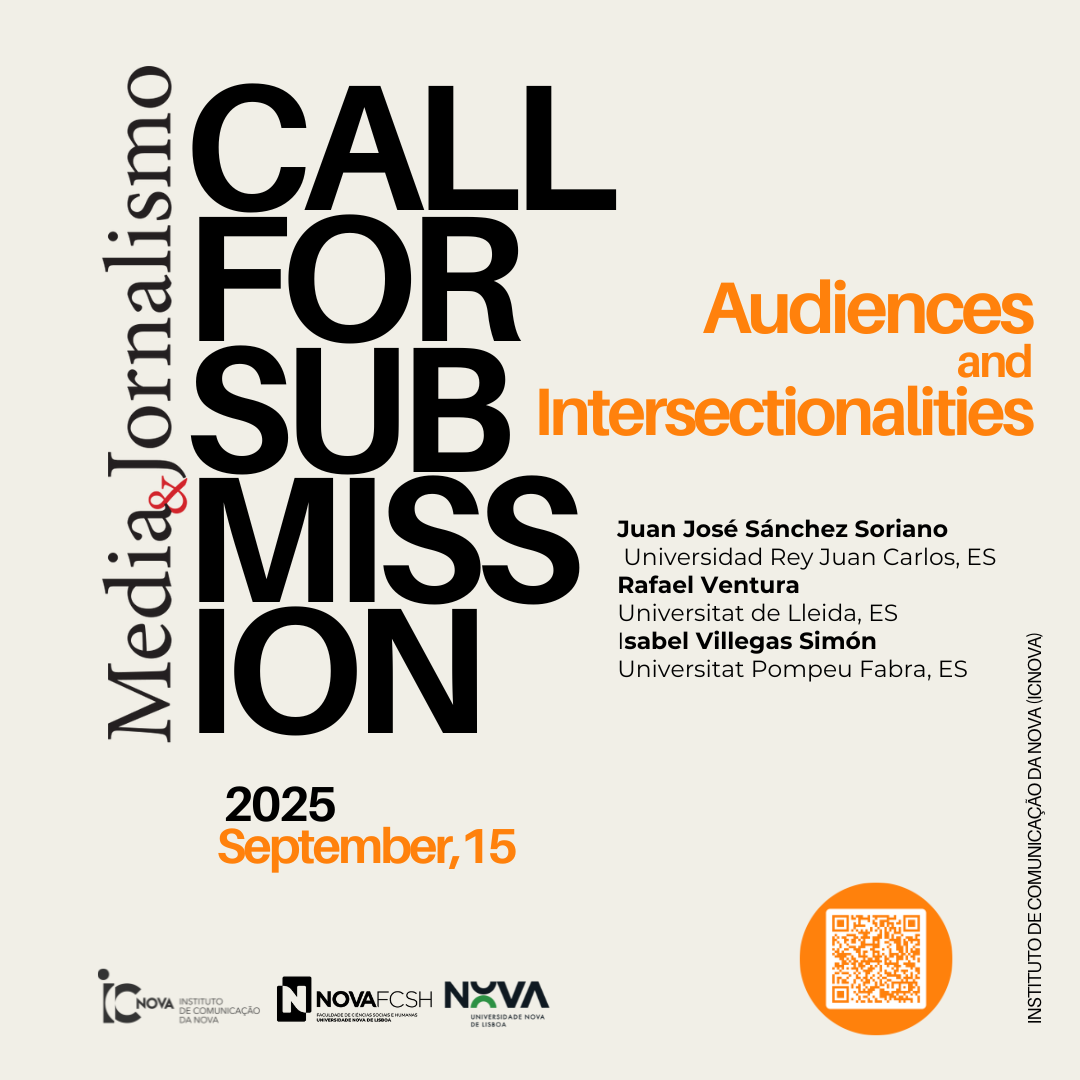Call For Papers
Special issue of Media Practice and Education Journal (March 2023)
Disrupting Surveillance: Media Arts Practice For a Reimagined Future
Guest editors: Patrícia Nogueira (ISMAI; ICNOVA), Ana Carvalho (ISMAI) and Joana Pestana (ISMAI) (disrupting.surveillance@ismai.pt)
We invite submissions for a special issue of The Journal of Media Practice and Education on the topic of Disrupting Surveillance
Deadline for 500-word Abstract Submissions: 15 March 2022
Deadline for Full Papers: 31 July 2022
Expected date of publication: March 2023
Surveillance in the 21st Century is characterized by ubiquitous data collection, storing and analysis, both visual and algorithmical, leading to a world of networked media and to diagnoses of surveillance and platform capitalism (Zuboff, 2019; Srnicek, 2017). In contemporary screen culture, namely with the omnipresence of surveillance devices, society has become a space of control (Pisters, 2012). Besides the ubiquitous surveillance, materialized by the proliferation of CCTV cameras scattered everywhere – in indoor and outdoor, public and private spaces – each one of us carries a personal camera, daily capturing everything around us, including ourselves and others, sharing our interests, the places where we go, the daily activities we do, the products we consume… actively contributing to a self-monitored society, or more precisely, to “societies of control” (Deleuze, 1992).
Therefore, surveillance is not just an external act, it is a voluntary, embodied everyday practice, which increasingly becomes an integral part of everyday life. It presents new sorting and controlling practices that promote new forms of visibility and control, new modes of power, as well as unintended consequences and disadvantages. Whereas such a scenario seems unavoidable, scholars and artists have been raising numerous questions to critique and reimagine the social and political landscape of contemporary surveillance society, refusing to indulge “technological determinism” (Jordan, 2008; Smith & Marx, 1994). While some artists and practitioners appropriate and repurpose surveillance images and technologies to interrogate the realm, others question the surveillance status quo by proposing strategies of disruption and escape.
The special issue therefore aims to provide a space for discussing strategies of subversion and alternatives concerning various forms of surveillance through technological means, relating to the crossover between artistic practices and technologies. The themed issue encourages bringing together a range of artistic, critical and scientific perspectives, affording visibility to recent artistic practices and research works, and exploring, broadly, the interdisciplinary frameworks for understanding contemporary surveillance and, particularly, how surveillance practices intersect with visual technologies, visual culture, and moving image studies.
The issue aims to interrogate a manifold of perspectives, from the aestheticization of surveillance to networked images, by exploring their intersections and derivations. We propose to discuss the way in which contemporary visual arts are contributing to the creation of new approaches and perspectives to interrogate the societies of surveillance, re-imagining and proposing alternative futures.
As so, we are seeking contributions of full papers that explore the intersection of Surveillance, Arts, and Technology from various perspectives. We are particularly interested in papers focusing on the practice-based media-arts research and analysis, its communication and circulation that respond to one or more of the special issue strands:
Film and Moving Images: the use, re-use, manipulation, and re-contextualization of surveillance, sousveillance, and self-surveillance moving and still images in contemporary film, video art and art installations, namely:
– The art of CCTV cameras / Cultural plays with CCTV;
– Drone images and aerial perspectives of control;
– Anthropocene and non-human gaze / imagery;
– Panopticism and cinematic surveillance: theories, practices, and representations;
– The relationship between voyeurism and surveillance;
– New visibilities of surveillance / Changing temporalities and spaces of surveillance;
– Surveillance art and the aesthetics of surveillance;
– Surveillance in post-colonial and decolonial film and art.
Digital Art: How the arts, and in particular the digital arts, the philosophy and theory of art and the reflection upon the arts from other areas of knowledge, has been critically reflecting the contemporary networked landscape of surveillance:
– Photography, film and personal strategies of production and distribution through social media;
– Performance and the technologies for online communication;
– The relationship of bodies to surveillance technologies;
– Interactions, creativity and aesthetics of and with A.I.;
– Individualization and the collective intelligence in times of digital surveillance;
– Artificial environments, personal devices, big data and networks of control;
– Sound ecologies of surveillance and the use of surveillance technologies for digital creation and production.
Critical Design and Visual Culture: interfaces, structures and technologies revealed or concealed in critical design works, and visual artworks that aim to disrupt surveillance and knowledge monopolies, delving into design fiction and speculative design and approaching broadly the following topics:
– Disrupting surveillance;
– Performative design and surveillance;
– Aesthetics and ethics of surveillance;
– Interfaces of and against surveillance;
– Wearable technology and interactive clothing;
– Structures and systems of resistance in design history;
– Alternative and speculative worlds.
To submit: Please send a 500-word abstract, and a 100-word bio per author to the guest editors at disrupting.surveillance@ismai.pt by 15 March 2022. Authors of accepted abstracts will be contacted in mid-April and invited to submit full contributions by 31 July 2022
Style guide for authors: https://www.tandfonline.com/action/authorSubmission?show=instructions&journalCode=rjmp21
Issue Schedule:
15 March 2022: 500-word proposals to be submitted (disrupting.surveillance@ismai.pt).
15 April 2022: Response from editors and, if successful, invitation to submit contribution.
31 July: Full Papers submission (5000 to 7000 words, incl. references).
August to November: Peer review period.
31 December: Submission of reviewed final papers.
March 2023: expected date of publication.
About the journal: Media Practice and Education is an international, peer-reviewed journal publishing high-quality, original research. Please see the journal’s Aims & Scope for information about its focus and peer-review policy.
Please note that this journal only publishes manuscripts in English.
Taylor & Francis is committed to peer-review integrity and upholding the highest standards of review.
There are no submission fees, publication fees or page charges for this journal.
References:
Crawford, Kate (2021). Atlas of AI. Yale University Press.
Deleuze, Gilles (1992). “Postscript on the Societies of Control”, The MIT Press, vol.59. pp.3-7.
Jordan, Tim (2008). Hacking: Digital Media and Technological Determinism. Cambridge: Polity Press.
Foucault, Michel (1991). Discipline and Punish – The Birth of the Prison. London: Penguin
Pisters, Patricia (2012). The Neuro-Image: A Deleuzian Film-Philosophy of Digital Screen. Stanford University Press.
Smith, Merritt Roe & Marx, Leo (1994). Does Technology Drive History? The Dilemma of Technological Determinism. Cambridge: MIT Press.
Srnicek, Nick (2017). Platform Capitalism. Cambridge, Malden: Polity.
Zuboff, Shoshana (2019). The Age of Surveillance Capitalism: The Fight for a Human Future at the New Frontier of Power. New York: Public Affairs.



